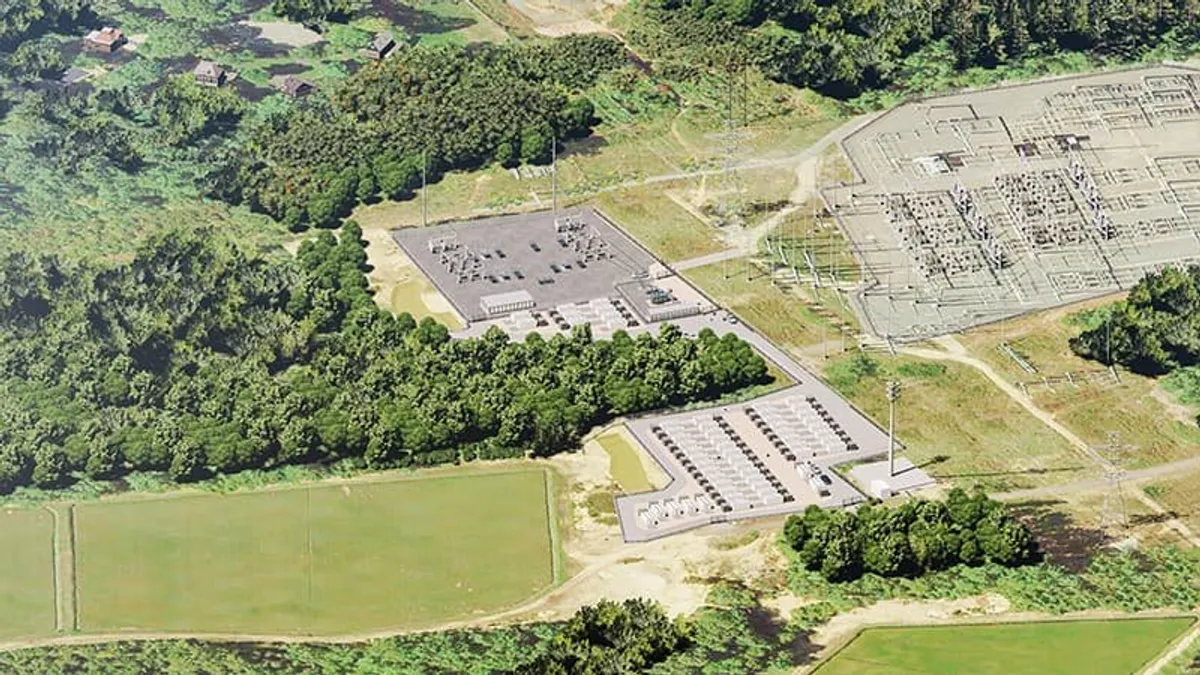Dive Brief:
- A Massachusetts agency has dismissed two proposed battery energy storage systems, saying state law does not provide “clear guidance” on whether a BESS is a generating facility and subject to its jurisdiction.
- Cranberry Point Energy Storage sought approval from the Energy Facilities Siting Board to build a 150 MW/300 MWh standalone battery energy storage system in Carver in southeastern Massachusetts. Medway Grid proposed to build a BESS with a storage capacity of 250 MW/500 MWh and an electric substation in Medway, about 45 miles southwest of Boston.
- In its request, Cranberry Point said the siting board has jurisdiction to review and approve generating facilities, defined in state law as “any generating unit designed for or capable of operating at a gross capacity of 100 MW or more, including associated buildings, ancillary structures, transmission and pipeline interconnections that are not otherwise facilities and fuel storage facilities.”
Dive Insight:
In its Medway Grid decision, the siting board said it “seems reasonable to conclude that since the siting statutes were adopted initially in 1973 and last updated significantly” in 1997, the laws reflect an electric system when BESS technology was “not a significant type of electrical infrastructure.”
Medway Grid touted its proposed BESS as faster, providing more flexible and lower-cost electricity and able to respond in milliseconds while also integrating with renewable energy and electric vehicles.
The proposals will now be reviewed by the state Department of Public Utilities.
A spokesperson for Eolian, of which Medway Grid is a subsidiary, looked past the siting board’s decision and said in an emailed statement that the company is “grateful for the path DPU has provided to proceed in bringing this project onto the grid for consumers.”
“As new technologies like ours emerge, public utilities will need to rise to the challenge of ensuring that antiquated regulations don’t stand in the way of needed progress for grid reliability and resilience,” Eolian said.
Cranberry Point did not respond to a request for comment.
In its decision, the siting board parsed the differences between energy storage and generation.
“As a matter of physics, batteries do not actually store electrical energy,” it said. “They don’t collect electrons from the grid, store the electrons and then later send those same electrons back.”
The board said batteries convert electrical energy into chemical energy, or charging, store the chemical energy and later transform the chemicals into electrical energy when the connected external circuit calls for electricity, or discharging.
Batteries involve energy, but “transformation,” or the use of the word “transform” by the Legislature was likely grounded in a “more conventional understanding” that generation involves the use of primary energy sources, such as fossil fuels, flowing water and other renewable sources that are transformed into electrical energy through combustion, the siting board said.
In comparison, state law defines “energy storage system” as a commercially available technology capable of absorbing energy, storing it and dispatching energy, the siting board said.
An environmental group, the Community Land and Water Coalition, hailed the siting board’s decisions as a “victory for proper energy facility siting and local communities faced with an onslaught of projects called ‘green’ and renewable, but that have big impacts not properly considered under current regulatory programs,”
Save the Pine Barrens, which is affiliated with the Community Land and Air Coalition, opposed the Carver project, saying the siting board does not have jurisdiction and the project is not “properly designed to address the dangers and risks of the lithium-ion battery facility in the dense residential neighborhood where it is proposed.”
Residents who opposed the project cited a local aquifer they said would be threatened with contamination by the project.
Cranberry Point said in its filing that from a “wholesale electricity market standpoint, the project will operate much like a generator,” acting as a source of wholesale electricity and provide wholesale services as other resources, by dispatching electricity into the marketplace.















